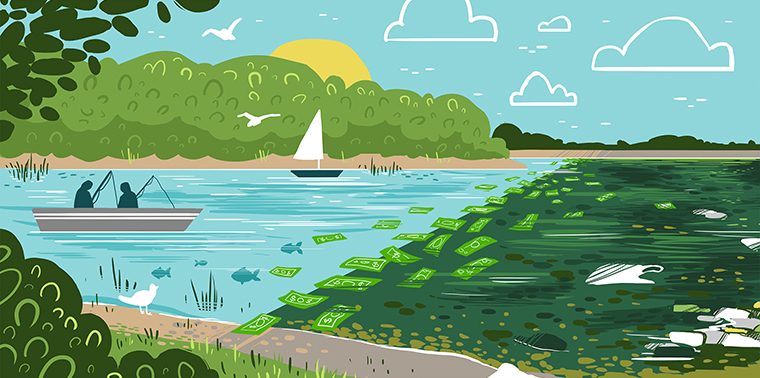March 29, 2017 — When I visited Onondaga Lake in 1999 as part of research I did as a student at Cornell, there was no evidence the lake was once home to vibrant waterfront resorts. Yet, in the late 1800s and early 1900s, Onondaga was considered “the Coney Island of Central New York,” with bustling amusement parks, waterfront resorts and even a lavish yacht club on its shores. In 1999, it was also difficult to tell that the lake had once been so polluted that, on hot summer days, families would roll up car windows as they drove by to block the stench coming from the water. Lax environmental protections had allowed decades of industrial pollution and municipal sewage to flow into the lake. By the 1940s, no one could swim in the water and the amusement parks, the Syracuse Yacht Club and resorts had all shut down. The lake was awash in bacteria and algae.
Today, as an aquatic ecologist with 18 years of research on freshwater under my belt, I know firsthand why this history of Onondaga Lake — once the most polluted lake in the U.S. — matters. The lake warns us of the tremendous costs of not having strong environmental protections in place — ecological costs as well as staggering economic costs. We can do incredible damage to bodies of water in very short periods of time. Cleaning them, on the other hand, takes decades and billions of dollars.
It is unfortunate that warnings such as the one Onondaga Lake offers are not being heeded by some officials. In February, 54 U.S. senators and 228 representatives voted to rescind the Stream Protection Rule. Representative Matt Gaetz of Florida has introduced a bill to terminate the U.S. Environmental Protection Agency, with co-sponsors from Alabama, Georgia, Kentucky, Mississippi, Texas and West Virginia. Scott Pruitt, the new head of the EPA, has sued the agency 14 times, including to block a rule that restricts how much mercury can be emitted by power plants. Emails released in February show that when Pruitt was Oklahoma’s attorney general he worked very closely with industry to try to weaken federal environmental protections. And the White House’s budget proposal includes devastating cuts to the EPA.
In many ways, the story of Onondaga Lake is a success story, giving us hope that, with effort, polluted waters can recover. But it is an extremely costly success story.
Onondaga Lake shows us what happens when we do not have sufficient environmental protection. Wastewater deposited tons of mercury in the lake, and 80-foot-tall waste beds on the shores leached other contaminants such as benzene, toluene, PCBs and cadmium into the lake. Raw and partially treated sewage with nutrient levels 100 times regulatory limits regularly flowed into Onondaga. Most of the fish species died, and the remaining fish had mercury levels too high for safe consumption, even 20 years after fishing was first banned and cleanup efforts began.
We Are All Stakeholders
After his confirmation, Pruitt tweeted that he is dedicated to working with stakeholders — who he then defined as “industry, farmers, ranchers, business owners” — on environmental stewardship. Onondaga Lake (not to mention the residents of Flint, Michigan, who are still unable to drink tap water due to lead contamination) shows us that we are all stakeholders when it comes to the environment, and that we all deal with the damage that accompanies environmental pollution.
Thanks to 1972’s Clean Water Act, actions forced by a series of lawsuits in the 1970s and ’80s, and the lake and surrounding areas being named a Superfund site in 1994, Onondaga Lake began to recover. Changes have been dramatic. People no longer need to roll up their windows when they drive by. Now, instead of just 9 to 12 fish species, the lake is home to 65. There’s even hope that swimmers might return to the lake in the next few years.
No one wants to deal with excessive regulation. But no one wants their favorite fishing site polluted, their swimming beach closed or their drinking water compromised.
But this recovery came at an enormous cost. The bill for the cleanup alone was over US$1 billion. And there also have been incalculable costs associated with damage to the ecosystem and lost recreational opportunities.
In many ways, the story of Onondaga Lake is a success story, giving us hope that, with effort, polluted waters can recover. But it is an extremely costly success story. When we remove environmental protections, we wind up paying later at a much higher cost.
If we lose the environmental protections we have now, we will end up with more stories like Onondaga Lake. We’ll watch lakes, streams and rivers go from vibrant resources valued for their beauty, recreational opportunities and ecosystem services to uninhabitable dead zones that are dangerous, unsightly, and avoided by tourists and others who would otherwise support the local economy.
No one wants to deal with excessive regulation. But no one wants their favorite fishing site polluted, their swimming beach closed or their drinking water compromised. No one wants Superfund sites in their communities. And no one wants to shoulder the extremely high costs of cleaning up sites once they’ve been polluted. We are all stakeholders when it comes to clean water, and we all pay dearly when our waters are polluted. ![]()
Ensia shares solutions-focused stories free of charge through our online magazine and partner media. That means audiences around the world have ready access to stories that can — and do — help them shape a better future. If you value our work, please show your support today.
Yes, I'll support Ensia!

-Sam Welch-